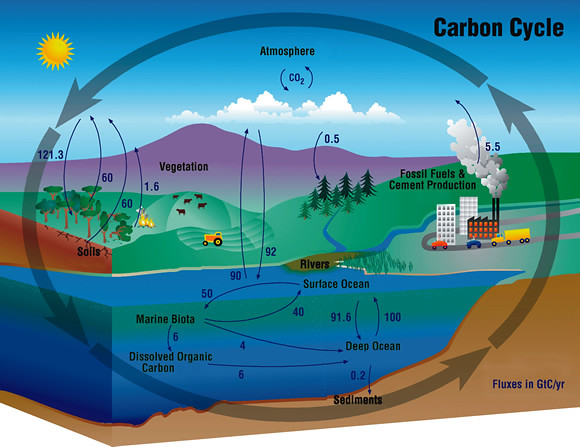Sunlight activates a chemical reaction between carbon dioxide and water that leads to the creation of plant sugar and oxygen. This process, known as  photosynthesis, creates food for the plant, releases breathable oxygen into the air and removes carbon from the atmosphere.
photosynthesis, creates food for the plant, releases breathable oxygen into the air and removes carbon from the atmosphere.
Carbon from the atmosphere can be absorbed by plants and soil. Preserving and allowing forests and grasslands to reach maturity increases their ability to store atmospheric carbon. This helps lower the amount of carbon that lingers in the atmosphere and limits carbon contributions to climate change.
 Carbon removed from the atmosphere and stored in plants and soil is released into the atmosphere during logging. More carbon is released when plant material is burned or processed into wood-based products. This release of carbon contributes to atmospheric carbon concentrations, which contribute to global climate change. While conserving four forests may not sound like it could make a measurable difference mitigating global climate change, every forest protected is one step closer to facilitating global-scale climate change mitigation. The National Forests and Grasslands of Texas also have a local impact on water, air and soil quality, benefitting nearby urban centers such as Houston.
Carbon removed from the atmosphere and stored in plants and soil is released into the atmosphere during logging. More carbon is released when plant material is burned or processed into wood-based products. This release of carbon contributes to atmospheric carbon concentrations, which contribute to global climate change. While conserving four forests may not sound like it could make a measurable difference mitigating global climate change, every forest protected is one step closer to facilitating global-scale climate change mitigation. The National Forests and Grasslands of Texas also have a local impact on water, air and soil quality, benefitting nearby urban centers such as Houston.
The U.S. Forest Service manages logging in the National Forests and Grasslands of Texas. Limiting logging in these forests is a step towards mitigating global climate change. Tell the Forest Service that you want to keep carbon in the forest. Comment on the National Forest and Grasslands of Texas Forest Plan during the revision process to tell the Forest Service to stop logging in your forests.
Image Credits: Masroor.nida.ns, NASA